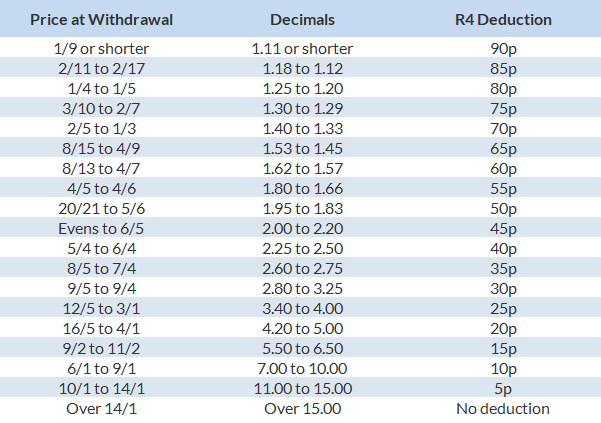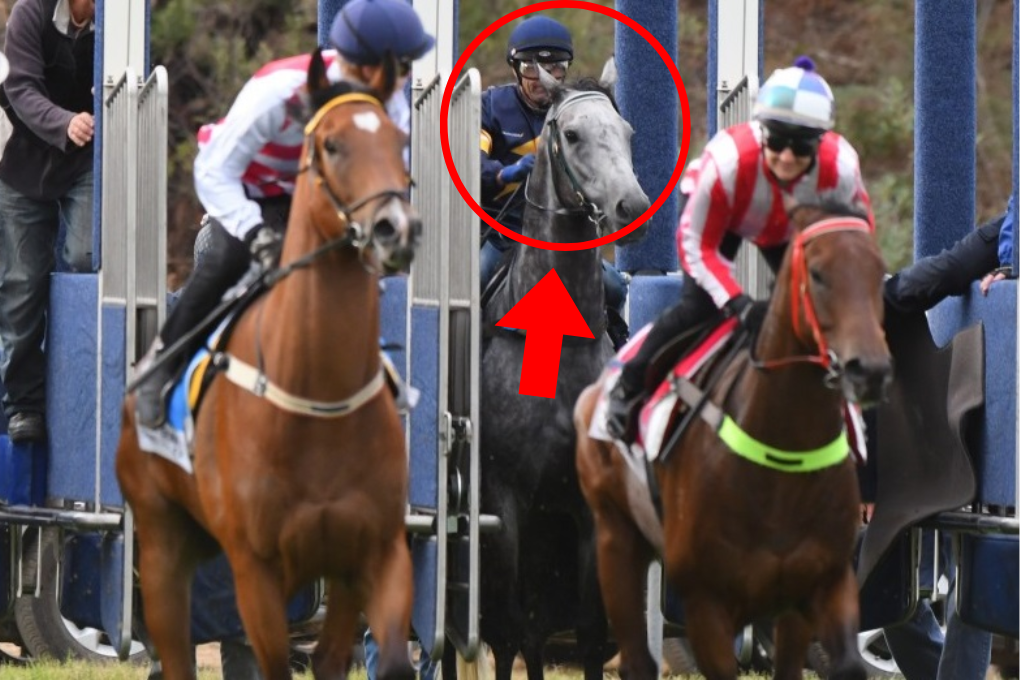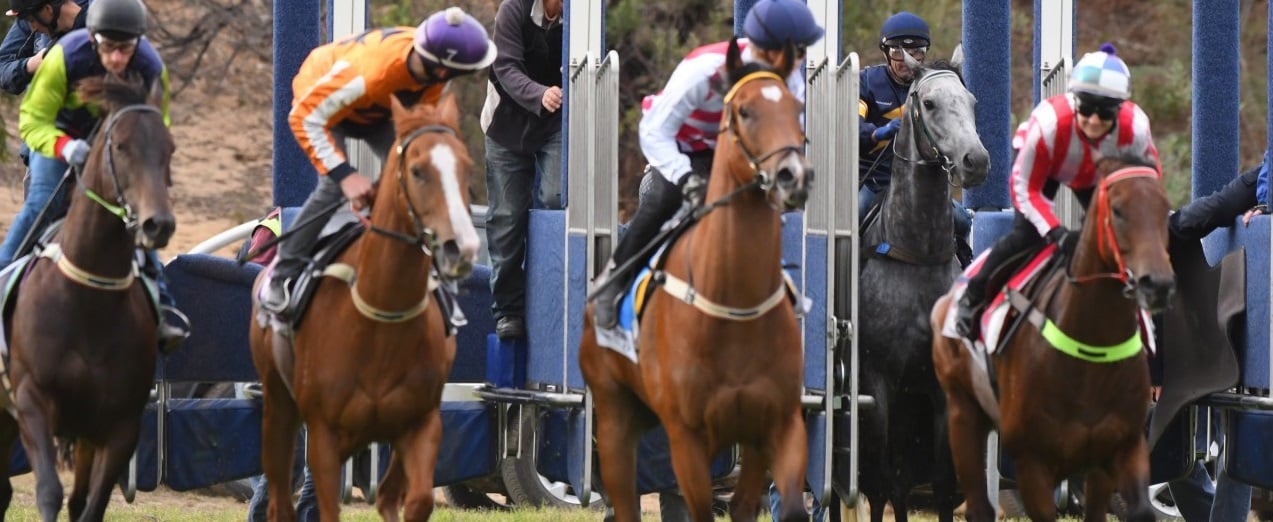Rule 4 price deductions can be extremely frustrating for sports bettors and traders alike.
If rule 4 is triggered on a market when you didn’t realise, it could see you losing a lot of money. Recently this happened to a handful of users on our community forum.
In a bid to stop it from happening to you too, we’ve created this article…
What Does Rule 4 Mean in Betting?
Rule 4 is the name given to a type of bet reduction that takes place on late withdrawals, before the start of an event.
The reduction is only applicable to bets that have already been placed.
Typically, rule 4 deductions correct the market for fixed-priced bets. However, staring price (SP) and in-play bets are sometimes subject to a Rule 4 deduction as the race turns in-play. This only happens when there is not enough time for the bookmaker or betting exchange to re-form the betting market.
When Does a Rule 4 Occur?
Before any horse racing ‘final declarations’ are made, rule 4 does not apply. This rule is simply there to protect people who have placed a bet between the final racing declarations (usually around 24-48 hours prior) and the official start time.
This is because the probability of a bet winning changes when some of the competition is withdrawn from the race.
If you watch the racing channels you will typically see a commentator state that a horse is going to be withdrawn before it happens in the market. This is particularly obvious on the betting exchanges with their big red ‘suspension’ messages.
But it’s not that simple…
Depending on your betting activity, if you are matched betting, sports trading or arbitrage betting it could mean a change to your overall position. Be careful!
Rule 4 Deductions For Exchange Markets:
On a betting exchange, similar rules apply. However, because it’s not a one-sided operation both back and lay bets are subject to the reduction factor – making it fair for all users.
Otherwise, you’d be losing out through no fault of your own.
To see how the reduction factors are applied to Betfair’s exchange see this link.
Rule 4 Trading Problem:
If you’re trading the exchange this can potentially spell disaster (as the forum posters mentioned above found out).
Why?
If for example a horse is ‘withdrawn at the start’ in the final seconds to post, there will not be time to re-form this betting market. This means that while both the in-play betting market and pre-race market will be subject to a rule 4 withdrawal, there is not time for the exchange to re-form and factor in the changes to pre-race bets on-screen. So when you hedge up your trading position on the ladders – it does not include the rule 4 reduction on your pre-race bet…
This of course means; if the horse you traded should win – you are out of pocket. But it just won’t show until the bets are settled (and your pre-race reduction is applied). Be careful with this, because the bigger you stake and the larger your position, the more you stand to lose…
Note: it’s quite rare this situation actually happens.
When Sports trading on Betfair in general it is always advisable to hedge your pre-race trading positions before the start of the race especially if you see a horse acting up in the paddocks and know of a possible late withdrawal. This will help you avoid the possible Betfair reduction factor from a late rule 4 being applied.
The only exception to this is if you intended to back pre-race and then trade out in-play, using a strategy such as back-to-lay.
How to Calculate a Rule 4 Deduction:
Not everyone reading this article will be interested in trading though, they may just be looking to confirm a Rule 4 deduction was correct!
Here’s a quick table to help…

Calculating your returns after the rule 4 deduction isn’t hard:
Profit x (1 – (Rule 4 / 100))
So, to show you:
Assuming you had backed at 5/1 (for a £10 stake) and that race had a 4/1 withdrawal, there would be a 20p in the pound rule 4 declared.
The numbers would look like this:
£50 x (1-(20/100))
= £50 x 0.8
= £40
Easy right?
Note: If there’s more than one withdrawal, you will need to add in the additional rule 4’s.
Why Does Rule 4 Exist?
The reason there are different reduction factors at different prices is simple – if a horse with a higher chance of winning is withdrawn, there is more value left in the remaining prices. Whereas if an outsider is withdrawn, little changes because it didn’t have much hope anyway!
If a bookmaker (or exchange) didn’t take rule 4 deductions from existing bets then it would be possible for customers to back all prices, at proportionate stakes and make a profit no matter what happened. In the same way, a bookmaker creates a book, but in reverse.
If that last line pickled your head a little, here’s a quick example:
To keep it simple, there’s a field of 3 runners to start
- Horse 1 @ 1/3 (1.33)
- Horse 2 @ 3/1 (4.0)
- Horse 3 @ 12/1 (13.0)
If the market leader is withdrawn and there is no rule 4 applied (horse 1) then you would be able to bet on horses 2 and 3 at both 3/1 and 12/1 respectively.
This means that if either horse 2 or 3 should win the race (one of them has to) then you would win more than your original stake, assuming you staked the same amount. The bookmaker, or person laying your bet would have no chance…
Thus the reason for rule 4 deductions. It’s considered the fairest way to maintain the betting markets current trading position when a horse is withdrawn.
What if Two Horses are Withdrawn?
If you should find there are more than one late withdrawal down at the start, there will be multiple rule 4’s applied. See the above calculation and factor in the extras!
Should Rule 4 Reductions On Horse Racing Stop Me From Betting?
Overall whilst it can be frustrating to see your odds on a horse racing bet get cut by a rule 4 deduction factor. The way that the rules are set out is a very fair way of dealing with the inevitability of a horse withdrawing. This is something that cannot avoided in a sport like horse racing.
On the upside when this happens your horse’s chances of winning a race do increase.
If your betting style is to look at potential outsiders and you are taking big odds that you think are valuable. Having the favourite be withdrawn and a rule 4 applied could actually be beneficial. It may be that the horses which are the 2nd and 3rd favourite are overvalued in your opinion, whilst the odds on the favourite are correct. In that situation suddenly your bet can actually look much better given the lineup of the race.
So no, there is no reason why the rule 4 reduction factor should put you off betting on horse racing.
More Help: Beginners School (10+ Help Articles for New Traders)



7 thoughts on “Rule 4 Price Deductions Help for Horse Racing (Deductions Table Included)”
Hi Caan, a lot of useful information, the above is another reason if you are serious about trading you must have as near to live pictures as possible.
Agreed, Mike. Live pics can stop you from getting in trouble as well as helping you out when exploiting certain market situations.
Rule 4’s don’t happen all that often as the market goes in-play, but just about every time it does happen I see people getting stung by this, I have too in the past. Hence it was well worth posting up!
Hiya Caan
The problem with Betfair rule for is that it takes the percentage from your stake unlike the Bookmakers. The Bookmakers and Betfairs rule 4 is very similar in that if a 2/1 shot is withdrawn and 3 on Betfair both would have a similar rule 4 say 30p in the pound or 30% with Betfair. But the Bookmakers will take 30p in the pound off your £20 winnings if you had £10 on it, so £6 but Betfair take 30% off the price assuming the same price I know it wouldn’t be quite be the same, but just for the purpose of this Betfair would take 30% off the 3, so 3 -0.9 =2.1 You would get £21 back with Betfair as opposed to the Bookmakers you would get £24 and that is because the 3 they take the percentage off includes your 1 which is your stake. To be fair if the price is 3 then the 30% should come off 2 as one of that price is your stake and that is the problem with Betfair rule 4
Rule 4 is great for the Bookies.
Funny how nothing is done for those of us who may have placed an early bet on ‘Dobbin’ being ridden by the great Jockey ‘Never beaten Jones’ only for a change to take place and ‘no-hope’ smith to take the ride instead. Can we get our money back? Can Pigs fly?!!!
I had an instance Caan where I placed a bet in the evening hours before the race the following afternoon. The odds were 4,6. I didn’t want those odds so selected odds of 5.0. Obviously it went unmatched so I selected for Betfair to keep these odds until they were matched. I checked in the morning, 4 hours before the race, and Betfair had taken my money, 60% of my stake had been taken at odds of 4.38 and the other 40% at odds of 4.22. I would never have taken these odds and it put me in a precarious position as my lay bets were at 4.7. The back odds for the horse in the morning when I looked were 5.6. So why do you think Betfair had taken my stakes below this? A horse was withdrawn during the morning but surely Betfair should not take odds that I do not authorise?
So basically, if your back bet wins and there is a rule 4 and you lay off on Betfair you are stuffed. Happened to me last night as thought it was industry standard that all bookmakers have same rules. My back bet was 4.25 and my lay bet was an average 3.7, a rare find!!! However, bookmaker took off 30%, Betfair 19.45%. Turned a guaranteed win into a loss even at those wonderful odds…..
This is correct, always hedge if you see a R4 is likely.